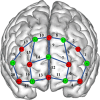Neural correlates of breath work, mental imagery of yoga postures, and meditation in yoga practitioners: a functional near-infrared spectroscopy study
- PMID: 38576867
- PMCID: PMC10991824
- DOI: 10.3389/fnins.2024.1322071
Neural correlates of breath work, mental imagery of yoga postures, and meditation in yoga practitioners: a functional near-infrared spectroscopy study
Abstract
Objective: Previous research has shown numerous health benefits of yoga, a multicomponent physical and mental activity. The three important aspects of both traditional and modern yoga are breath work, postures, and meditation. However, the neural mechanisms associated with these three aspects of yoga remain largely unknown. The present study investigated the neural underpinnings associated with each of these three yoga components in long- and short-term yoga practitioners to clarify the neural advantages of yoga experience, aiming to provide a more comprehensive understanding of yoga's health-promoting effects.
Methods: Participants were 40 Chinese women, 20 with a long-term yoga practice and 20 with a short-term yoga practice. Functional near-infrared spectroscopy was conducted while participants performed abdominal breathing, mental imagery of yoga postures, and mindfulness meditation. The oxygenated hemoglobin concentrations activated in the brain during these three tasks were used to assess the neural responses to the different aspects of yoga practice. The self-reported mastery of each yoga posture was used to assess the advantages of practicing yoga postures.
Results: Blood oxygen levels in the dorsolateral prefrontal cortex during breath work were significantly higher in long-term yoga practitioners than in short-term yoga practitioners. In the mental imagery of yoga postures task, self-reported data showed that long-term yoga practitioners had better mastery than short-term practitioners. Long-term yoga practitioners demonstrated lower activation in the ventrolateral prefrontal cortex, with lower blood oxygen levels associated with performing this task, than short-term yoga practitioners. In the mindfulness meditation task, blood oxygen levels in the orbitofrontal cortex and the ventrolateral prefrontal cortex were significantly higher in long-term yoga practitioners than in short-term yoga practitioners.
Conclusion: The three core yoga components, namely, yogic breathing, postures, and meditation, showed differences and similarities in the activation levels of the prefrontal cortex. Long-term practice of each component led to the neural benefits of efficient activation in the prefrontal cortex, especially in the dorsolateral prefrontal cortex, orbitofrontal cortex, and ventrolateral prefrontal cortex.
Keywords: breath; fNIRS; meditation; posture; yoga.
Copyright © 2024 Li, Zhou, Zhang, Wang and Wang.
Conflict of interest statement
The authors declare that the research was conducted in the absence of any commercial or financial relationships that could be construed as a potential conflict of interest.
Figures




References
-
- Benjamini Y., Hochberg Y. (1995). Controlling the false discovery rate: a practical and powerful approach to multiple testing. J. Royal Stat. Soc. Series B 57, 289–300.
-
- Brinsley J., Smout M., Girard D., Davison K. (2022). Acute mood and cardiovascular responses to moderate intensity vinyasa yoga, static yin yoga and aerobic exercise in people with depression and/or anxiety disorders: a 5-arm randomised controlled trial. Ment. Health Phys. Act. 22:100450. doi: 10.1016/j.mhpa.2022.100450 - DOI
LinkOut - more resources
Full Text Sources

